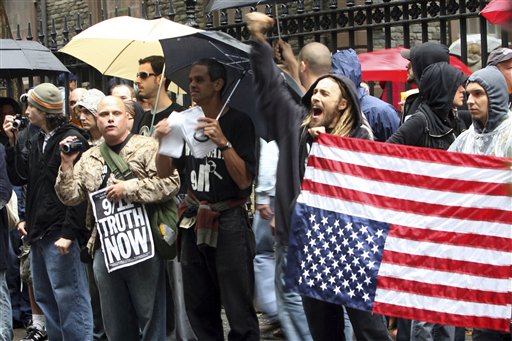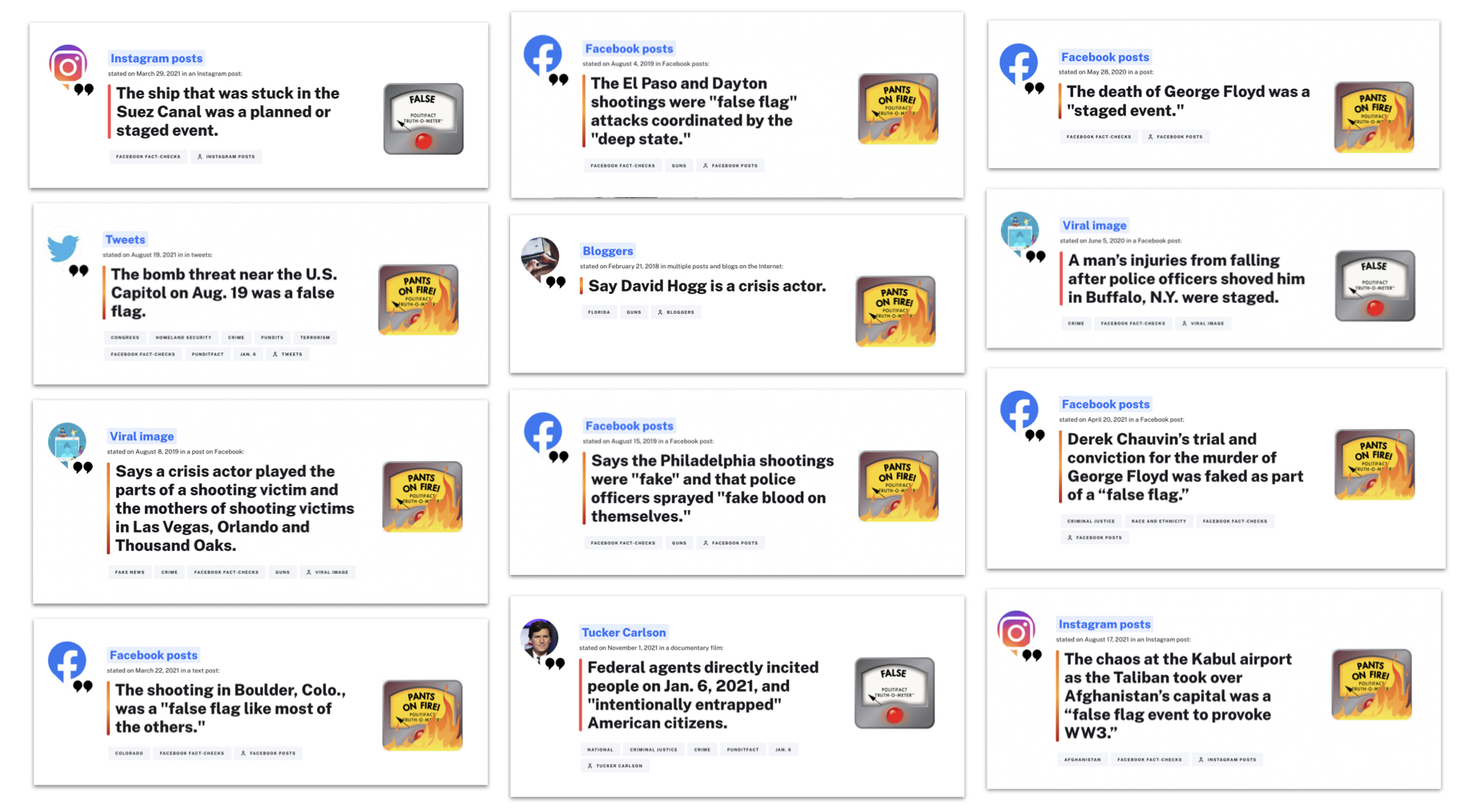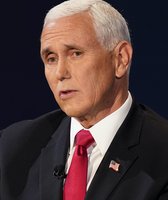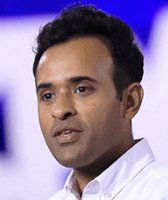Stand up for the facts!
Our only agenda is to publish the truth so you can be an informed participant in democracy.
We need your help.
I would like to contribute

State Department spokesman Ned Price during a briefing on Feb. 1, 2022. Administration officials have not revealed details on how they knew Russia was plotting a false flag operation involving Ukraine. (AP)
If Your Time is short
-
For generations, governments have mounted false flag operations, in which they justify military action by deceptively accusing an enemy of a violent act.
-
However, actual false flags plotted in recent history are outnumbered by dubious conspiracy theories that label real, verifiable crisis events as “false flags.”
-
Experts warn that social media rumors alleging “false flags” should be viewed skeptically.
Citing newly acquired intelligence, the U.S. in early February accused Russia of plotting a fake attack by Ukrainian forces as a pretext for invading the neighboring country.
U.S. officials provided few details about the alleged "false flag" attack, saying it could jeopardize sources and methods used to obtain the intelligence. But they said the disinformation campaign could involve the dissemination of a propaganda video featuring faked explosions, images of destruction and crisis actors posing as mourners.
The officials said they went public with the information in order to thwart Russia’s alleged scheme and to make it known that future military action could be premised on falsehoods. They said Russia has a history of running similar operations to justify action against Ukraine.
The allegation of a staged event carried out by an adversary evoked memories of other claimed "false flags" that have driven conspiracy theories for decades. In recent years, the term "false flag" has been invoked to explain everything from the 9/11 attacks to school shootings to the Jan. 6, 2021, attack at the U.S. Capitol.
Some proponents of "false flag" conspiracy theories were quick to conflate the two. Fox News host Tucker Carlson — a promoter of the baseless claim that the storming of the Capitol on Jan. 6, 2021, was a "false flag" orchestrated by the FBI — made the U.S. government’s allegation a focal point of his show. He aired and reacted to a clip of State Department spokesperson Ned Price saying that U.S. intelligence showed Russia was planning to stage a fabricated attack.
"A false flag operation? Really?" Carlson said mockingly on Feb. 4. "That is a jarring term to hear from a Joe Biden employee, much less an official. Because until yesterday, we were under the impression that false flag operations didn’t exist. They said if they did exist, it was only within the diseased imaginations of conspiracy theorists like Alex Jones and his minions in QAnon."
In fact, some confirmed false flag operations have occurred throughout history, though they were difficult to pull off. Perhaps the greatest legacy of these faux events is that they laid the foundation of distrust that has fueled some of the most high-profile modern-day conspiracy theories that allege that real, well-documented events were also staged. These include the 9/11 attacks and school shootings such as those in Newtown, Connecticut, and Parkland, Florida.
"The revelation of real, proven, government lies and conspiracies helps explain the attraction of false flag conspiracy theories," said Kathryn Olmsted, a professor of history at the University of California-Davis, and the author of a book on conspiracy theories.
How should Americans reconcile the existence of false flag operations throughout history with the rise in dubious conspiracy theories alleging, for example, that school shootings like the Sandy Hook massacre were staged to push gun control?
The original definition of "false flag" stems from the misuse of literal flags.
Historically, a false flag operation referred to a military force or a ship flying another country's flag for the purposes of deception. Under international law, this is usually considered illegal. The Hague Convention IV of 1907, for instance, forbids any signatory from making "improper use of a flag of truce, of the national flag or of the military insignia and uniform of the enemy."
Japanese troops entering Shenyang during the Mukden Incident in 1931. (Public domain)
One of the best-known historical examples of a real false flag operation was mounted by Nazi Germany in 1939 as justification for starting World War II.
The Gestapo staged a Polish raid on a German broadcasting tower at Gleiwitz, in current-day Poland. The Nazis left behind a dead "saboteur" — in reality a German farmer with Polish sympathies who’d been shot by the Gestapo — as well as several dead Germans, who in reality were concentration camp prisoners killed and dressed as German guards, said David Silbey, a Cornell University historian. "Hitler used the incidents to justify the invasion of Poland," he said.
Another example, Silbey said, was the Mukden Incident of 1931, in which the Japanese Army blew up a section of railway line in northern China to justify its invasion of Manchuria.
Meanwhile, historians believe that a 1939 incident near Mainila, a Soviet village near the border with Finland, was a false flag operation, with Soviets firing on their own border post as a pretext for invading Finland.
Another possible example involving Russia occurred in 1999. Following a series of bombings believed to be carried out by Chechnyan militants, several people were apprehended planting a large bag of explosives in front of an apartment building in the city of Ryazan, said Scott Radnitz, an associate professor of Russian and Eurasian studies at the University of Washington.
"They were revealed to be from the security services, or FSB," Radnitz said. "The FSB did not disavow them but instead claimed they were doing a training exercise and the bags were full of sugar."
The episode was used as the basis for a new Russian military campaign in Chechnya — and boosted the career of the relatively unknown then-Prime Minister, Vladimir Putin, Radnitz said. "If this operation was engineered by the government, it would check all the boxes to qualify as a false flag operation—and a momentous one."
Historians pointed to at least one example of a false flag plan hatched by the United States government, Operation Northwoods was proposed in 1962 by the U.S. military to kill Americans and blame the attack on Cuba’s Fidel Castro, thereby offering a reason to invade and depose the Cuban dictator, Olmsted said. The civilian leadership in the Kennedy administration rejected the proposal before it could be carried out.
Because false flag operations are by nature deceptive, it’s hard to know how common they are.
Intelligence agencies do launch false flag operations, "but telling the difference between a real one and a false allegation is really hard," said Lance Janda, a military historian at Cameron University. "It often amounts to how much faith you have in the source."
That said, false flag operations require significant effort to come across as plausible, so other deceptive operations — such as spreading disinformation — may be more common, experts said. And sometimes governments can exaggerate actual events for political gain.
Two well-known incidents in American history — the explosion of the U.S.S. Maine that helped initiate the Spanish-American War, and the Gulf of Tonkin incident that led the U.S. to expand military operations in Vietnam — weren’t false flag operations per se, since U.S. forces didn’t dress up in enemy uniforms and attack American assets. But both featured exaggerated government responses to real incidents.
"Both occurred under murky circumstances and were then exploited to agitate for war against the presumed aggressors," Radnitz said.
The layers of deception that surround false flag operations make it hard to determine whether an incident is really a false flag — including the recent U.S. allegations against Russia.
"I wonder if Russia was happy to have us discover the plot to inflame the climate of fear and anxiety that may be their actual goal, as opposed to an actual invasion," said Michael O'Hanlon, a senior fellow at the Brookings Institution.
9/11 conspiracy theorists demonstrate on the eighth anniversary of the terrorist attacks in New York. (AP)
The actual false flags plotted in history appear to have been outpaced in recent years by dubious conspiracy theories that label real events as "false flags" that, in turn, were allegedly used to justify the expansion of government powers. That line of thinking took off after the 9/11 attacks spawned a new war overseas and a scaled up surveillance state.
Growing distrust in government, combined with the revelation that the Bush administration had been deceptive about weapons of mass destruction in Iraq, helped produce a "9/11 truth" movement. Supporters of this movement offered a number of alternative explanations for the day’s events, despite the fact that their theories were repeatedly debunked.
The central idea surrounding many of the theories claiming the U.S. government made or let the attack happen, Radnitz said, was that 9/11 was a "false flag," and that the resulting shock was a pretext for the government to invade Iraq, spy on Americans and stomp on civil liberties.
One proponent of the 9/11 conspiracy theories was InfoWars founder Alex Jones, who helped direct an infamous documentary that pushed the bogus counter-narrative. Years later, Jones used his InfoWars platform to push another "false flag" conspiracy theory.
Jones alleged that the Sandy Hook shooting in Connecticut, in which 20 children and six adults died, was faked to push gun control, and that the victims’ families were crisis actors. (Crisis actors are actors purportedly trained to portray victims during disasters and other emergencies.)
Jones has since been banned by several technology companies for promoting those and other conspiracy theories, and he has lost defamation lawsuits brought by the families of Sandy Hook victims. But social media users have spread similarly bogus "false flag" and "crisis actor" claims following other shootings, such as those in Parkland, Florida, Dayton, Ohio, and El Paso, Texas.
"The people who are susceptible to these theories are already distrustful of government and of the mainstream news media," Olmsted said. "And fringe conspiracy theory entrepreneurs like Alex Jones amplify these fears and help spread them."
Social media users have also made baseless "false flag" allegations about the murder of George Floyd, the protests that followed and the conviction of his killer, Derek Chauvin; about a former Facebook who became a whistleblower; about the blockage of the Suez Canal; about a bomb threat outside the Capitol; about the U.S. withdrawal and evacuation from Afghanistan; about the administration of COVID-19 vaccines; and about other real-world events.
The storming by Trump supporters of the Capitol — an event broadcast live on TV — was also recast by Carlson and other conservatives in the media and politics as a "false flag" staged by antifa, the FBI, or both. The purpose, Carlson has claimed, was to entrap Trump voters.
"False flag" theories don’t always require massive leaps in logic, Radnitz said. After the U.S. war effort in Iraq soured, for instance, some Americans who saw the Bush administration use 9/11 to build support for the war entertained the possibility that it engineered the attack in the first place.
"The idea of a false flag attack is intuitively plausible because people have the sense that politicians take advantage of crises as pretexts to advance their political goals," Radnitz said.
Government secrecy around intelligence can propel such theories as well.
But experts warn that social media rumors alleging that big events in the news are "false flags" should be viewed skeptically. Real false flag operations are logistically complex; they rope in significant numbers of people and force leaders to consider complicated ethical dilemmas.
"We should always ask the question: Does it seem likely that a conspiracy of this size could actually remain hidden?" Olmsted said. "It’s especially hard to keep secrets in the digital age."
Kate Starbird, an expert on misinformation at the University of Washington, said in a Twitter thread that Russia, in particular, seeks to foster this kind of confusion among Americans.
Russia’s agencies "both use false flag operations and accuse others of using false flag operations," Starbird wrote. "It’s both projection and an effective tactic of making it difficult for people to make sense of events in the world. Undermining trust in information."
She added: "The fact that we (as a broader public) can’t differentiate between a real threat and a conspiracy theory is the point of those kinds of active measures."
CORRECTION, Feb. 8, 2022: This story has been updated to clearly attribute a quote to Michael O’Hanlon and to include comment from Scott Radnitz that provides more clarity about his position.
Our Sources
Fox News on YouTube, "Tucker: Republicans and Democrats are 'hysterical' about this," Feb. 4, 2022
Associated Press, "US says new intel shows Russia plotting false flag attack," Feb. 3, 2022
New York Times, "U.S. Exposes What It Says Is Russian Effort to Fabricate Pretext for Invasion," Feb. 3, 2022
U.S. Department of State, "Department Press Briefing – February 3, 2022," Feb. 3, 2022
U.S. Department of Defense, "Pentagon Press Secretary John F. Kirby Holds a Press Briefing," Feb. 3, 2022
The New York Times, "Alex Jones Loses by Default in Remaining Sandy Hook Defamation Suits," Nov. 15, 2021
ABC News, "U.S. Military Wanted to Provoke War With Cuba," Jan. 7, 2006
PolitiFact, "No evidence to support claim that CDC staged monkey crash," Jan. 31, 2022
PolitiFact, "The 2021 Lie of the Year: Lies about the Jan. 6 Capitol attack and its significance," Dec. 15, 2021
PolitiFact, "Do you think Boris Johnson faked his booster shot? Let’s look closer at the needle," Dec. 7, 2021
PolitiFact, "Tucker Carlson’s ‘Patriot Purge’ film on Jan. 6 is full of falsehoods, conspiracy theories," Nov. 5, 2021
PolitiFact, "Tucker Carlson’s conspiracy theory about FBI and Jan. 6 continues to be wrong," Nov. 4, 2021
PolitiFact, "No evidence whistleblower Frances Haugen was planted by Facebook," Oct. 8, 2021
PolitiFact, "How the 9/11 attacks helped shape the modern misinformation, conspiracy theory industry," Sept. 9, 2021
PolitiFact, "No evidence that US Air Force plane evacuating Afghanistan airport was fake," Aug. 27, 2021
PolitiFact, "Conservative influencers wrongly claim Capitol bomb threat was ‘false flag,'" Aug. 24, 2021
PolitiFact, "No, the chaos in Afghanistan isn’t a ‘false flag,'" Aug. 19, 2021
PolitiFact, "No, Derek Chauvin’s conviction in George Floyd murder wasn’t fake," April 21, 2021
PolitiFact, "No, the Suez Canal blockage was not staged or planned," March 30, 2021
PolitiFact, "Boulder shooting was not a ‘false flag’ attack," March 23, 2021
PolitiFact, "No, the Capitol insurrection was not staged by antifa," Jan. 8, 2021
PolitiFact, "There’s no proof antifa stormed the Capitol. The rumor spread quickly anyway," Jan. 7, 2021
PolitiFact, "Conspiracy theory targets first recipient of UK COVID-19 vaccine as crisis actor," Dec. 9, 2020
PolitiFact, "Floyd’s death wasn’t filmed before the pandemic," June 16, 2020
PolitiFact, "These photos don’t prove George Floyd is alive," June 11, 2020
PolitiFact, "No evidence Buffalo protester’s injuries were staged," June 9, 2020
PolitiFact, "The protests over George Floyd’s death are real," June 1, 2020
PolitiFact, "Conspiracy theory falsely claims George Floyd’s death was staged," May 29, 2020
PolitiFact, "No, police officers didn’t fake injuries during the Philadelphia shooting," Aug. 19, 2019
PolitiFact, "No, the same woman didn’t pretend to be a shooting victim and the mothers of shooting victims," Aug. 14, 2019
PolitiFact, "Why do some people think mass shootings are staged every time?" Aug. 8, 2019
PolitiFact, "No, the El Paso and Dayton mass shootings were not ‘false flag’ operations," Aug. 5, 2019
PolitiFact, "PolitiFact’s Lie of the Year: Online smear machine tries to take down Parkland students," Dec. 11, 2018
PolitiFact, "Conspiracy claims that Syrian gas attack was 'false flag' are unproven," April 7, 2017
Email interview with David Silbey, Cornell University historian, Feb. 6, 2022
Email interview with Lance Janda, military historian at Cameron University, Feb. 4, 2022
Email interview with Michael O’Hanlon, senior fellow at the Brookings Institution, Feb. 4, 2022
Email interview with Anthony Clark Arend, professor of government and foreign service at Georgetown University, Feb. 4, 2022
Email interview with John Pike, director of globalsecurity.org, Feb. 4, 2022
Email interview with Scott Radnitz, professor of Russian and Eurasian studies at the University of Washington, Feb. 6, 2022
Email interview with Kathryn Olmsted, professor of history at the University of California-Davis, Feb. 6, 2022
















































